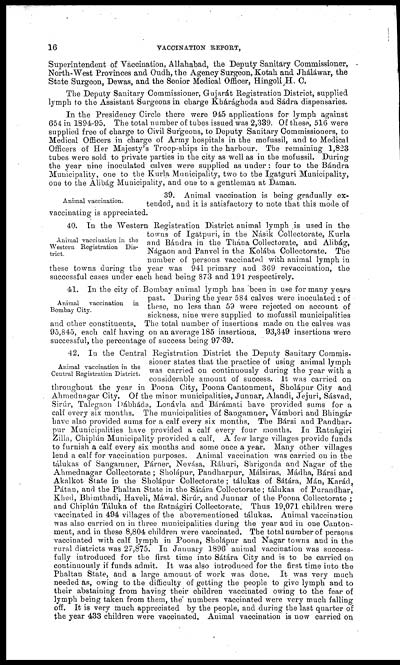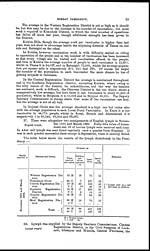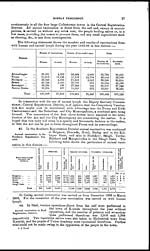Medicine - Vaccination > 1899-1928 - Report on vaccination in the Bombay Presidency > Vaccination in Bombay 1889-1901 > 1895-1896 - Report on vaccination in the Bombay Presidency, for the year 1895-96 with appendices
(304) Page 16
Download files
Individual page:
Thumbnail gallery: Grid view | List view

16 VACCINATION REPORT,
Superintendent of Vaccination, Allahabad, the Deputy Sanitary Commissioner,
North-West Provinces and Oudh, the Agency Surgeon, Kotah and Jháláwar, the
State Surgeon, Dewas, and the Senior Medical Officer, Hingoli H. C.
The Deputy Sanitary Commissioner, Gujarát Registration District, supplied
lymph to the Assistant Surgeons in charge Khárághoda and Sádra dispensaries.
In the Presidency Circle there were 945 applications for lymph against
654 in 1894-95. The total number of tubes issued was 2,339. Of these, 516 were
supplied free of charge to Civil Surgeons, to Deputy Sanitary Commissioners, to
Medical Officers in charge of Army hospitals in the mofussil, and to Medical
Officers of Her Majesty's Troop-ships in the harbour. The remaining 1,823
tubes were sold to private parties in the city as well as in the mofussil. During
the year nine inoculated calves were supplied as under : four to the Bándra
Municipality, one to the Kurla Municipality, two to the Igatguri Municipality,
one to the Alibág Municipality, and one to a gentleman at Daman.
Animal vaccination.
39. Animal vaccination is being gradually ex-
tended, and it is satisfactory to note that this mode of
vaccinating is appreciated.
Animal vaccination in the
Western Registration Dis-
trict.
40. In the Western Registration District animal lymph is used in the
towns of Igatpuri, in the Násik Collectorate, Kurla
and Bándra in the Thána Collectorate, and Alibág,
Nágaon and Panvel in the Kolába Collectorate. The
number of persons vaccinated with animal lymph in
these towns during the year was 941 primary and 369 revaccination, the
successful cases under each head being 873 and 191 respectively.
Animal vaccination in
Bombay City.
41. In the city of. Bombay animal lymph has been in use for many years
past. During the year 584 calves were inoculated : of
these, no less than 59 were rejected on account of
sickness, nine were supplied to mofussil municipalities
and other constituents. The total number of insertions made on the calves was
95,845, each calf having on an average 185 insertions. 93,349 insertions were
successful, the percentage of success being 97.39.
Animal vaccination in the
Central Registration District.
42. In the Central Registration District the Deputy Sanitary Commis-
sioner states that the practice of using animal lymph
was carried on continuously during the year with a
considerable amount of success. It was carried on
throughout the year in Poona City, Poona Cantonment, Sholápur City and
Ahmednagar City. Of the minor municipalities, Junnar, Alandi, Jejuri, Sásvad,
Sirúr, Talegaon Dábháda, Lonávla and Bárámati have provided sums for a
calf every six months. The municipalities of Sangamner, Vámbori and Bhingár
have also provided sums for a calf every six months. The Bársi and Pandhar-
pur Municipalities have provided a calf every four months. In Ratnágiri
Zilla, Chiplún Municipality provided a calf. A few large villages provide funds
to furnish a calf every six months and some once a year. Many other villages
lend a calf for vaccination purposes. Animal vaccination was carried on in the
tálukas of Sangamner, Párner, Nevása, Ráhuri, Shrigonda and Nagar of the
Ahmednagar Collectorate; Sholápur, Pandharpur, Málsiras, Mádha, Bársi and
Akalkot State in the Sholápur Collectorate; tálukas of Sátára, Mán, Karád.
Pátan, and the Phaltan State in the Sátára Collectorate; tálukas of Purandhar,
Khed, Bhimthadi, Haveli, Máwal, Sirúr, and Junnar of the Poona Collectorate ;
and Chiplún Táluka of the Ratnágiri Collectorate. Thus 19,071 children were
vaccinated in 494 villages of the abovementioned tálukas. Animal vaccination
was also carried on in three municipalities during the year and in one Canton-
ment, and in these 8,804 children were vaccinated. The total number of persons
vaccinated with calf lymph in Poona, Sholápur and Nagar towns and in the
rural districts was 27,875. In January 1896 animal vaccination was success-
fully introduced for the first time into Sátára City and is to be carried on
continuously if funds admit. It was also introduced for the first time into the
Phaltan State, and a large amount of work was done. It was very much
needed as, owing to the difficulty of getting the people to give lymph and to
their abstaining from having their children vaccinated owing to the fear of
lymph being taken from them, the numbers vaccinated were very much falling
off. It is very much appreciated by the people, and during the last quarter of
the year 433 children were vaccinated. Animal vaccination is now carried on
Set display mode to: Large image | Zoom image | Transcription
Images and transcriptions on this page, including medium image downloads, may be used under the Creative Commons Attribution 4.0 International Licence unless otherwise stated. ![]()
| Permanent URL | https://digital.nls.uk/91030363 |
|---|
| Attribution and copyright: |
|
|---|




